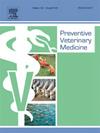Characterising the knowledge, attitudes and practices of Australian veterinarians regarding Q fever and the diagnosis and reporting of coxiellosis
IF 2.2
2区 农林科学
Q1 VETERINARY SCIENCES
引用次数: 0
Abstract
Q fever is a serious zoonotic disease that readily transmits from animals to humans. Infection in animals is known as coxiellosis. Veterinarians are in a key position to provide early detection of coxiellosis in animals that can aid the prevention or recognition of human cases. However, there is little information available about veterinary ability and willingness to diagnose and report this disease in animals. This study was conducted to assess the knowledge, attitudes and practices of veterinarians regarding coxiellosis. An online survey was performed that targeted veterinarians in Australia from 2020 to 2021 and 122 responses were obtained. Results showed that veterinarians report a moderate amount of knowledge about Q fever in humans but an overwhelming lack of confidence around recognising and diagnosing the disease in animals with 70–80 % of respondents reporting that they were ‘not at all confident’ or ‘not very confident’. Most respondents (68 %) believed that coxiellosis was an important infection in animals because of its human health consequences and 84 % would report the infection if it were diagnosed. Barriers to diagnosis and reporting identified in this study include disease unfamiliarity, perception of disease insignificance, and futility of disease identification if there are no effective strategies in place for using diagnosis and notification of coxiellosis in controlling infection. Despite a deficit of self-reported knowledge and confidence regarding the diagnosis of coxiellosis, Australian veterinarians consider it to be an important zoonotic disease with implications for human health and are willing to collaborate with human health colleagues in a One Health approach around this issue.
描述澳大利亚兽医对Q热和柯埃尔病的诊断和报告的知识、态度和做法。
Q热是一种严重的人畜共患疾病,很容易从动物传染给人类。动物感染被称为蛲虫病。兽医在早期发现动物体虫病方面处于关键地位,这有助于预防或识别人间病例。然而,关于兽医诊断和报告动物中这种疾病的能力和意愿的信息很少。本研究旨在评估兽医对蛲虫病的知识、态度和做法。在2020年至2021年期间对澳大利亚的兽医进行了一项在线调查,获得了122份回复。结果显示,兽医报告对人类Q热有中等程度的了解,但在识别和诊断动物疾病方面极度缺乏信心,70- 80% %的受访者报告他们“完全没有信心”或“不是很有信心”。大多数答复者(68% %)认为,由于其对人类健康的影响,克氏菌病是一种重要的动物感染,如果确诊,84% %的人会报告感染情况。本研究确定的诊断和报告障碍包括疾病不熟悉、认为疾病不重要,以及如果没有有效的策略来利用诊断和通报克氏体虫病来控制感染,则疾病识别是徒劳的。尽管缺乏自我报告的关于克氏体虫病诊断的知识和信心,但澳大利亚兽医认为这是一种影响人类健康的重要人畜共患疾病,并愿意在这个问题上与人类卫生同事合作,采取“一个健康”的方法。
本文章由计算机程序翻译,如有差异,请以英文原文为准。
求助全文
约1分钟内获得全文
求助全文
来源期刊

Preventive veterinary medicine
农林科学-兽医学
CiteScore
5.60
自引率
7.70%
发文量
184
审稿时长
3 months
期刊介绍:
Preventive Veterinary Medicine is one of the leading international resources for scientific reports on animal health programs and preventive veterinary medicine. The journal follows the guidelines for standardizing and strengthening the reporting of biomedical research which are available from the CONSORT, MOOSE, PRISMA, REFLECT, STARD, and STROBE statements. The journal focuses on:
Epidemiology of health events relevant to domestic and wild animals;
Economic impacts of epidemic and endemic animal and zoonotic diseases;
Latest methods and approaches in veterinary epidemiology;
Disease and infection control or eradication measures;
The "One Health" concept and the relationships between veterinary medicine, human health, animal-production systems, and the environment;
Development of new techniques in surveillance systems and diagnosis;
Evaluation and control of diseases in animal populations.
 求助内容:
求助内容: 应助结果提醒方式:
应助结果提醒方式:


